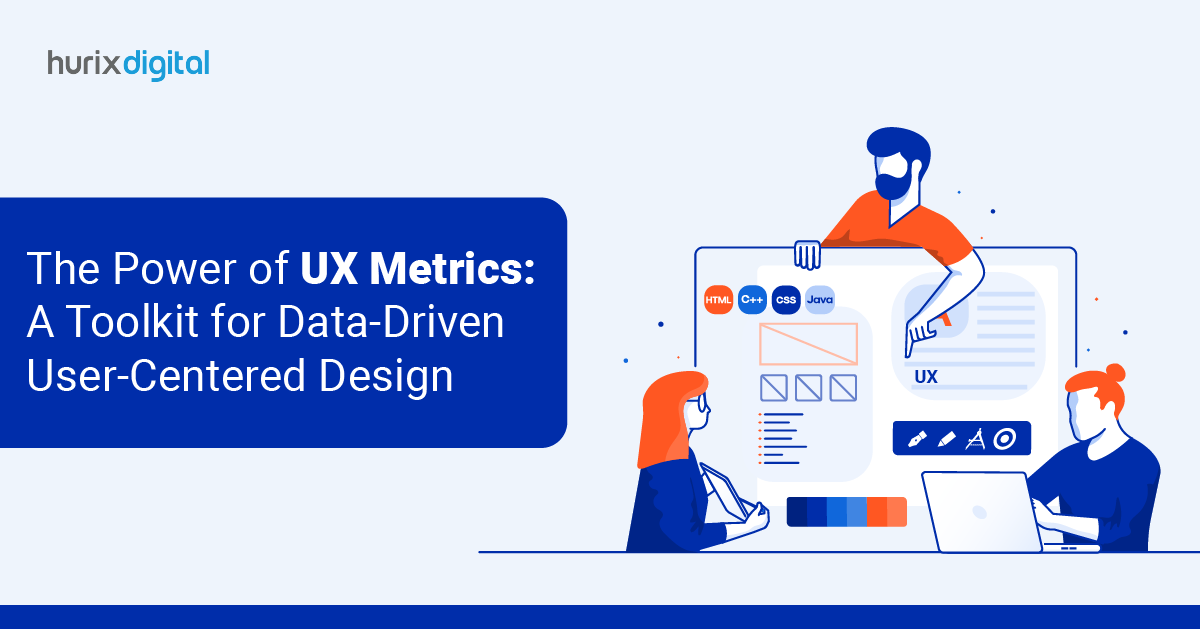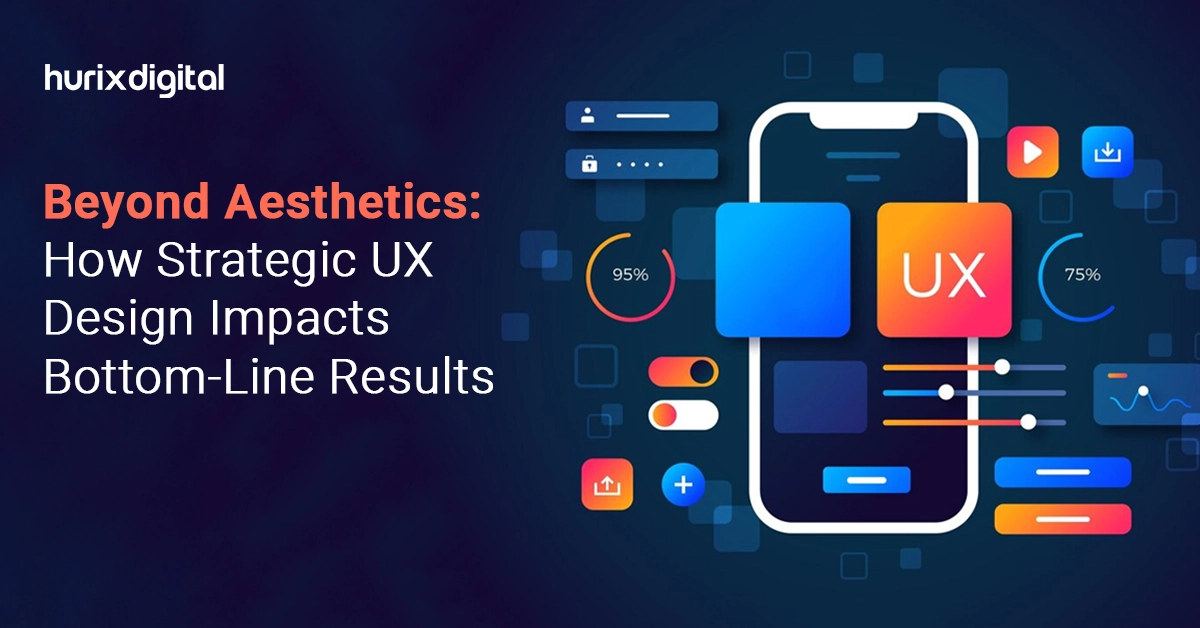
How UX-Driven Innovation Streamlines IT Operations and Enhances Productivity?
Summary
This blog explores UX as a Service, highlighting benefits like user-centered design, predictive analytics, and scalability, with applications such as intuitive dashboards and self-service portals.
The push toward a digital-first environment has left CIOs and CTOs facing immense pressure to optimize IT operations and user experiences. As technology ecosystems become increasingly complex, organizations are shifting from traditional IT models to a user-centric IT solutions approach. That’s where UX as a service plays a central role.
UX-driven innovation is a transformational approach that drives productivity and helps organizations adapt faster. It’s not just about aesthetics. It’s also about solving pain points, reducing cognitive load, and achieving IT operations efficiency.
Let’s explore how embracing human-centered design can bring out the best in your IT systems and keep your business at the cutting edge.
Table of Contents:
- The Core of UX as a Service: How User-Centered Design Shapes IT Efficiency
- Key Components of UX-Driven Innovation in IT Operations
- How UX-Driven Innovation Drives Productivity?
- Practical Applications of UX as a Service in Real-World IT
- How UX-Driven IT Supports Digital Transformation?
- How UX as a Service Future-Proofs Your IT Operations?
- Wrapping Up
The Core of UX as a Service: How User-Centered Design Shapes IT Efficiency
A user-centric IT solution centers on creating functional and intuitive IT systems. Traditionally, IT systems have focused on backend functionality, often sidelining the user’s experience.
Today, however, UX as a Service prioritizes user experience and is reshaping IT landscapes to provide ease of use, accessibility, and adaptability.
Key Benefits of UX as a Service in IT
- Increased Usability: IT systems are progressively complicated, with interconnected tools, data-intensive workflows, and cross-functional team dependencies. Thoughtful UX allows employees to work more efficiently by simplifying workflows and reducing unnecessary steps.
- Minimized Downtime: Better user interfaces mean fewer errors and a reduced need for constant IT support, leading to smoother operations.
- Enhanced Agility: Systems designed with users in mind can quickly adapt to new demands, making your IT infrastructure more agile.
Also Read: What Secret Ingredients Make Accessible Design a Masterpiece in UX?
Key Components of UX-Driven Innovation in IT Operations
To implement effective UX as a Service, it’s important to integrate the following components into IT systems:
1. Human-Centered Design
A human-centered design approach prioritizes the end user’s experience, ensuring systems support natural workflows.
- Why it Matters: When users are involved in the design process, the result is IT tools that align seamlessly with daily routines.
- Added Value: When IT systems are user-friendly, employees adapt faster and can start contributing immediately. Simplified, intuitive systems mean less time spent training employees on complex IT processes, which leads to substantial cost savings for organizations.
2. User-Centric IT Solutions
User-centric IT Solutions offer personalized experiences, helping employees engage more efficiently with technology. For example, personalized dashboards for IT admins that highlight critical alerts make system monitoring more efficient and reduce response times.
- Why it Matters: User-centric solutions emphasize ease of use, which can significantly reduce help desk requests. This allows IT teams to focus on strategic projects.
- Added Value: When interfaces are easy to navigate, IT teams can detect and resolve problems quickly. Clear system dashboards and real-time alerts allow for faster troubleshooting.
3. Data-Driven UX for Predictive Maintenance
Data-driven UX enables IT teams to leverage predictive analytics. They can anticipate and fix issues before they disrupt workflows.
- Why it Matters: Predictive tools with intuitive interfaces enable faster issue detection, which enhances overall IT operations efficiency.
- Added Value: Effective UX design in IT provides actionable insights in a clear and accessible format. When data dashboards are well-designed, decision-makers can quickly access and interpret critical metrics, improving the speed and accuracy of decision-making.
4. Scalable UX Design for Future-Ready IT Systems
Scalable UX allows companies to grow without overhauling entire systems. This guarantees consistent workflows as demands increase.
- Why it Matters: Scalable design can adapt to increased data loads or additional functionality, helping IT departments to innovate without disruptions.
- Added Value: A UX-focused approach ensures system architecture supports future upgrades, new functionalities, and changing user needs.
How UX-Driven Innovation Drives Productivity?
UX-driven innovation is more than a trend; it’s a fundamental shift toward designing IT solutions that align with human behavior. UX for IT Systems is a strategic investment in speed and accuracy.
Here’s how it contributes directly to productivity:
- Reduces User Friction: Well-designed systems reduce friction points, allowing users to work with fewer disruptions. By minimizing unnecessary steps, UX-driven IT systems enable faster task completion.
- Improves Workflow Clarity: Clutter-free and logically organized UX designs offer employees a clear path to accomplish tasks. They reduce the time spent searching for information or figuring out the next steps, leading to consistent data handling and more reliable operations.
- Enhances Collaboration and Communication: UX-designed communication tools simplify collaboration, helping teams stay on the same page. They improve information flow and support better cross-departmental communication. This reduces project delay, which is essential for fast-paced digital work environments.
Practical Applications of UX as a Service in Real-World IT
Adopting UX as a Service within IT operations doesn’t only create a theoretical benefit—it directly translates into tangible, real-world advantages.
1. Intuitive IT Dashboards
Custom dashboards help IT teams track key performance metrics in real time, reducing the time spent on navigation. For example, interactive, role-specific dashboards allow IT staff to focus on metrics that matter most to them.
2. Self-Service Portals for End-User Support
Self-service portals with an optimized UX allow users to address common technical issues, freeing up IT resources for complex tasks. These portals help users with issues like password resets or access requests quickly.
They often include troubleshooting guides and FAQs, helping employees resolve issues without IT intervention. This improves productivity across the organization.
3. Intuitive Project Management Platforms
Integrated project management tools allow teams to collaborate on projects, track progress, and manage resources efficiently. This increases visibility and augments task allocation, helping your team stay aligned.
How UX-Driven IT Supports Digital Transformation?
Ensure a user-centric approach for any organization undergoing digital transformation. Many transformation efforts fail due to low adoption, often because systems are complex or unintuitive. Over 80% of digital transformation projects fail due to poor collaboration.
When IT teams prioritize UX from the outset, they build systems that are more likely to be embraced by employees. This reduces resistance to change and supports long-term success.
How UX as a Service Future-Proofs Your IT Operations?
UX as a Service not only addresses current operational needs but also prepares your IT systems for future demands. By designing adaptable and scalable interfaces, your organization can handle emerging challenges without disrupting daily operations.
- Supports Continuous Improvement: User feedback loops allow IT teams to improve interfaces based on user needs.
- Facilitates Rapid Adaptation: In an ever-changing digital landscape, UX-focused systems are easier to adapt, ensuring your IT operations remain efficient.
Also Read: Beyond Usability: Top 10 Components for Mastering UX through Accessibility
Wrapping Up
The future belongs to those who prioritize innovation and design. Incorporating UX as a Service into IT operations is a strategic move that pays dividends in productivity, efficiency, and employee satisfaction. With the right user-centric IT solutions, you can empower employees to achieve their best work.
Are you ready to elevate your IT operations with UX-driven innovation? At Hurix Digital, we craft human-centered design solutions that drive business growth and empower digital transformation.
From UX reviews to scalable digital product designs, our expertise brings a strategic edge to your business. Connect with Hurix Digital and explore the potential of user-centered technology to build an efficient, resilient future. Let us show you how UX-driven innovation can redefine your IT landscape for the better.

Associate Vice President – User Experience Design
A passionate UX leader driving business excellence through design, strategic growth, and innovation. With a track record of over 10 years, I’ve spearheaded impactful customer experiences across Financial Services, Banking, EdTech, MedTech, and E-commerce realms.






